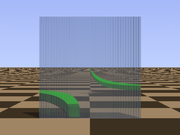
METATOY
Encyclopedia

Metamaterial
Metamaterials are artificial materials engineered to have properties that may not be found in nature. Metamaterials usually gain their properties from structure rather than composition, using small inhomogeneities to create effective macroscopic behavior....
s; METATOYs even satisfy a few definitions of metamaterials, but are certainly not metamaterials in the usual sense. When seen from a distance, the view through each individual telescopic optical component acts as one pixel of the view through the METATOY as a whole. In the simplest case, the individual optical components are all identical; the METATOY then behaves like a homogeneous, but pixellated, window that can have very unusual optical properties (see the picture of the view through a METATOY).
METATOYs are usually treated within the framework of geometrical optics
Geometrical optics
Geometrical optics, or ray optics, describes light propagation in terms of "rays". The "ray" in geometric optics is an abstraction, or "instrument", which can be used to approximately model how light will propagate. Light rays are defined to propagate in a rectilinear path as far as they travel in...
; the light-ray-direction change performed by a METATOY is described by a mapping
Map (mathematics)
In most of mathematics and in some related technical fields, the term mapping, usually shortened to map, is either a synonym for function, or denotes a particular kind of function which is important in that branch, or denotes something conceptually similar to a function.In graph theory, a map is a...
of the direction of any incoming light ray onto the corresponding direction of the outgoing ray. The light-ray-direction mappings can be very general. METATOYs can even create pixellated light-ray fields that could not exist in non-pixellated form due to a condition imposed by wave optics.
Much of the work on METATOYs is currently theoretical, backed up by computer simulations. A small number of experiments have been performed to date; more experimental work is ongoing.
Examples of METATOYs

- a pair of identical lenses (focal length
 ) that share the same optical axis (perpendicular to the METATOY) and that are separated by
) that share the same optical axis (perpendicular to the METATOY) and that are separated by  , that is they share one focal plane (a special case of a refracting telescopeRefracting telescopeA refracting or refractor telescope is a type of optical telescope that uses a lens as its objective to form an image . The refracting telescope design was originally used in spy glasses and astronomical telescopes but is also used for long focus camera lenses...
, that is they share one focal plane (a special case of a refracting telescopeRefracting telescopeA refracting or refractor telescope is a type of optical telescope that uses a lens as its objective to form an image . The refracting telescope design was originally used in spy glasses and astronomical telescopes but is also used for long focus camera lenses...
with angular magnification -1); - a pair of non-identical lenses (focal lengths
 and
and  ) that share the same optical axis (again perpendicular to the METATOY) and that are separated by
) that share the same optical axis (again perpendicular to the METATOY) and that are separated by  , that is they again share one focal plane (a generalization of the former case, a refracting telescope with any angular magnification);
, that is they again share one focal plane (a generalization of the former case, a refracting telescope with any angular magnification); - a pair of non-identical lenses (focal lengths
 and
and  ) that share one focal plane, that is, they share the direction of the optical axis, which is not necessarily perpendicular to the METATOY, and they are separated by
) that share one focal plane, that is, they share the direction of the optical axis, which is not necessarily perpendicular to the METATOY, and they are separated by  (a generalization of the former case);
(a generalization of the former case); - a prismPrism (optics)In optics, a prism is a transparent optical element with flat, polished surfaces that refract light. The exact angles between the surfaces depend on the application. The traditional geometrical shape is that of a triangular prism with a triangular base and rectangular sides, and in colloquial use...
; - a Dove prismDove prismA Dove prism is a type of reflective prism which is used to invert an image. Dove prisms are shaped from a truncated right-angle prism. A beam of light entering one of the sloped faces of the prism undergoes total internal reflection from the inside of the longest face and emerges from the...
(see pictures).
Examples of inhomogeneous METATOYs include
- the moiré magnifier, which is based on deliberately "mis-aligned" pairs of confocal microlens arraysMicrolensA microlens is a small lens, generally with a diameter less than a millimetre and often as small as 10 micrometres . The small sizes of the lenses means that a simple design can give good optical quality but sometimes unwanted effects arise due to optical diffraction at the small features...
; - Fresnel lensFresnel lensA Fresnel lens is a type of lens originally developed by French physicist Augustin-Jean Fresnel for lighthouses.The design allows the construction of lenses of large aperture and short focal length without the mass and volume of material that would be required by a lens of conventional design...
es, which can be seen as non-homogeneous METATOYs made from prisms; - frosted glassFrosted glassFrosted glass is produced by the sandblasting or acid etching of clear sheet glass. It has the effect of rendering the glass translucent by scattering of light during transmission, thus blurring images while still transmitting light.Applications:...
, which can be seen as an extreme case of an inhomogeneous, random METATOY made from prisms.
Note that examples of METATOYs as defined above have existed long before analogies with metamaterials were noted and it was recognized that METATOYs can perform wave-optically forbidden ray-direction mappings (in pixellated form).
Wave-optical constraints on light-ray fields and METATOYs
Wave optics describes light at a more fundamental level than geometrical opticsGeometrical optics
Geometrical optics, or ray optics, describes light propagation in terms of "rays". The "ray" in geometric optics is an abstraction, or "instrument", which can be used to approximately model how light will propagate. Light rays are defined to propagate in a rectilinear path as far as they travel in...
. In the ray-optics limit (in which the optical wavelength
Wavelength
In physics, the wavelength of a sinusoidal wave is the spatial period of the wave—the distance over which the wave's shape repeats.It is usually determined by considering the distance between consecutive corresponding points of the same phase, such as crests, troughs, or zero crossings, and is a...
tends towards zero) of scalar optics (in which light is described as a scalar wave, an approximation that works well for paraxial light with uniform polarization), the light-ray field r
 corresponding to a light wave
corresponding to a light wave  is its phase gradient,
is its phase gradient,where
 is the phase of the wave
is the phase of the wave  . But according to vector calculus, the curl of any gradient is zero, that is
. But according to vector calculus, the curl of any gradient is zero, that isand therefore
This last equation is a condition, derived from wave optics, on light-ray fields.
(Each of the three equations that makes up this vector equation expresses the symmetry of the second spatial derivatives
Symmetry of second derivatives
In mathematics, the symmetry of second derivatives refers to the possibility of interchanging the order of taking partial derivatives of a functionfof n variables...
, which is how the condition was initially formulated.)
Using the example of ray-rotation sheets, it was shown that METATOYs can create light-ray fields that do not satisfy the above condition on light-ray fields.
Relationship with metamaterials
METATOYs are not metamaterialMetamaterial
Metamaterials are artificial materials engineered to have properties that may not be found in nature. Metamaterials usually gain their properties from structure rather than composition, using small inhomogeneities to create effective macroscopic behavior....
s in the standard sense. The acronym "metamaterial for rays" was chosen because of a number of similarities between METATOYs and metamaterials, which are discussed below, along with the differences.
In addition, metamaterials provided the inspiration for early METATOYs research, as summarized in the following quote :
Motivated by the desire to build optical elements that have some of the visual properties of metamaterials on an everyday size scale and across the entire visible wavelength spectrum, we recently started to investigate sheets formed by miniaturized optical elements that change the direction of transmitted light rays.
Similarities with metamaterials
In a number of ways, METATOYs are analogous to metamaterialMetamaterial
Metamaterials are artificial materials engineered to have properties that may not be found in nature. Metamaterials usually gain their properties from structure rather than composition, using small inhomogeneities to create effective macroscopic behavior....
s :
- structure: metamaterials are arrays of small (sub-wavelength size) wave-optical components (electro-magnetic circuits resonant with the optical frequency), whereas METATOYs are arrays of small (so that they work well as pixels), telescopic, "ray-optical components";
- functionality: both metamaterials and METATOYs can behave like homogeneous materials, in the case of metamaterials a volume of material, in the case of METATOYs a sheet material, in both cases with very unusual optical properties such as negative refraction.
Differences with metamaterials
Arguably amongst the most startling properties of metamaterials are some that are fundamentally wave-optical, and therefore not reproduced in METATOYs. These include- amplification of evanescent waves, which can, in principle, lead to perfect lenses ("superlenses") and magnifying superlenses ("hyperlenses");
- reversal of the phase velocityPhase velocityThe phase velocity of a wave is the rate at which the phase of the wave propagates in space. This is the speed at which the phase of any one frequency component of the wave travels. For such a component, any given phase of the wave will appear to travel at the phase velocity...
; - reversal of the Doppler shift.
On the other hand, because they are not bound by wave-optical constraints on light-ray fields, it can be argued that METATOYs can perform light-ray-direction changes that metamaterials could not, unless a METATOY was effectively built out of metamaterials.
External links
- METATOYs project
- Optics Group
- Department of Physics and Astronomy, University of GlasgowUniversity of GlasgowThe University of Glasgow is the fourth-oldest university in the English-speaking world and one of Scotland's four ancient universities. Located in Glasgow, the university was founded in 1451 and is presently one of seventeen British higher education institutions ranked amongst the top 100 of the...
, UK - Didactic article on METATOYs




